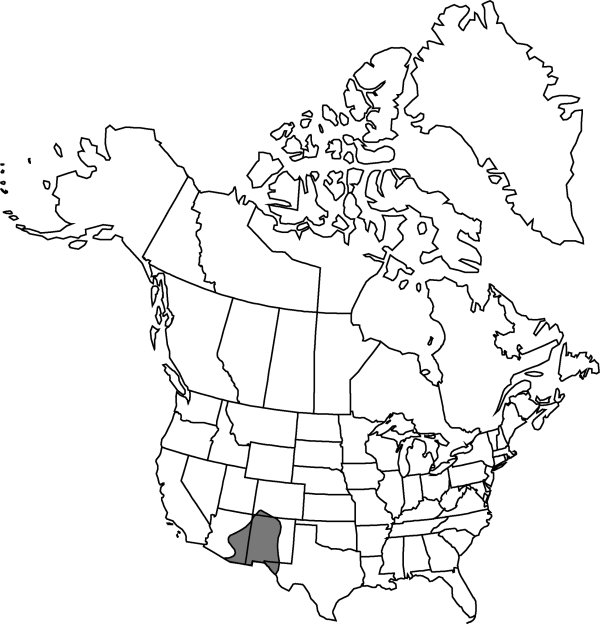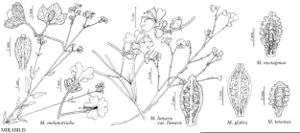Mirabilis melanotricha
Phytologia 85: 99. 1999.
Stems erect or strongly ascending, leafy mostly in proximal 2/3 of plant, openly forked distally, 5–12 dm, pubescent basally with minute curved hairs in 2 lines, spreading glandular-pilose distally. Leaves ascending at 10–60°, progressively reduced toward infloresence; petiole 0.8–3 cm; blade bright green, narrowly triangular-ovate to ovate, 3–10 × 0.8–4 cm, ± thin, base acute, obtuse, truncate, or cordate, apex acute to attenuate, or obtuse, often rounded at tip, surfaces glabrous or rarely puberulent. Inflorescences axillary and terminal, few branched, ± evenly forked and open; peduncle 2–9 mm, spreading glandular-villous, crosswalls of hairs dark purple or black; involucres blushed with dark violet or black, at least in median region, widely bell-shaped, 3–6 mm in flower, 4–7 mm in fruit, spreading viscid-villous, 40–50% connate, lobes oblong to ovate, apex broadly acute. Flowers 3 per involucre; perianth bright purple-pink, 0.9–1.2 cm. Fruits dark grayish to blackish brown, sometimes dark, dull, reddish-brown, narrowly obovoid, 3–4 mm, spreading-pilose, hairs often apearing loosely shaggy and somewhat tufted, (0.1–) 0.2–0.3 mm; ribs ± same color as sulci, low and round, 0.7–1 times width of sulci, 0.5 times as wide as high, slightly rugose or warty; sulci almost smooth to slightly rugose or with very low tubercules.
Phenology: Flowering mid summer–early fall.
Habitat: Conifer woodlands, mountain meadows, roadsides
Elevation: 1900-3000 m
Distribution

Ariz., Colo., N.Mex., Tex., Mexico
Discussion
The erect habit, bright green and usually glabrous foliage, and dark involucres of Mirabilis melanotricha are distinctive in combination. Once collected and pressed, M. melanotricha becomes yet another “difficult” Mirabilis. In 1911, P. C. Standley noted that this species (as Allionia melanotricha) was one of the most variable in the genus, and in 1918 he submerged it in A. comata, which in the field is a grayish green, clump-forming, glandular-pubescent plant with decumbent-ascending stems. Mirabilis melanotricha occurs in more mesic situations mostly at elevations above M. comata (here in synonymy in M. albida). It intergrades into M. linearis along its northern edge and lower elevations in New Mexico through M. linearis var. decipiens (Standley) S. L. Welsh. In the northeastern portion of its range, it may intergrade with M. nyctaginea; fruits in that region sometimes are slightly more reddish and more tuberculate than usual. Along the eastern portion of its range, it also intergrades into M. albida, as plants become more pubescent and fleshy. B. L. Turner (1993b) noted that M. comata (apparently in the sense of its common usage, as applied to plants here classified as M. melanotricha) might remain distinct from his concept of M. albida, which included C. F. Reed’s (1969) comprehensive M. oblongifolia.
Selected References
None.
Lower Taxa
No values specified."dm" is not declared as a valid unit of measurement for this property.
